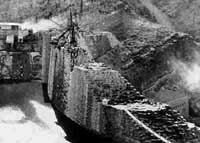Phoenix Area Office - Facilities
A Brief History of Roosevelt Dam
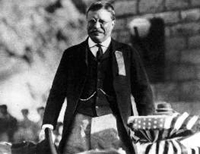 Former President Theodore Roosevelt dedicated the dam named in his honor March 18, 1911. The reservoir contained 526,875 acre feet of water and was at elevation 163.15 on the dam, the day of the 1st dedication. At 4:15 p.m., the car carrying Roosevelt rounded the point from which he took his first view of the dam. The sight of Roosevelt's car, was the signal for the discharge of 11 guns at the dam, followed by the cheers from the hundreds gathered (upwards of 1,000 people attended the event.) The U.S. flag and the blue Reclamation Service flag floated above the parapets of the dam. Roosevelt said the two proudest achievements of his administration were the Reclamation Act and the Panama Canal.
Former President Theodore Roosevelt dedicated the dam named in his honor March 18, 1911. The reservoir contained 526,875 acre feet of water and was at elevation 163.15 on the dam, the day of the 1st dedication. At 4:15 p.m., the car carrying Roosevelt rounded the point from which he took his first view of the dam. The sight of Roosevelt's car, was the signal for the discharge of 11 guns at the dam, followed by the cheers from the hundreds gathered (upwards of 1,000 people attended the event.) The U.S. flag and the blue Reclamation Service flag floated above the parapets of the dam. Roosevelt said the two proudest achievements of his administration were the Reclamation Act and the Panama Canal.
"If there could be any monument which would appeal to any man, surely this is it. You could not have done anything which would have pleased and touched me more than to name this great dam, this reservoir site, after me, and I thank you from my heart for having done so... As soon as it was done (the National Reclamation Act signed into law), ...I said, now I want this work divided fairly... and as Arizona and New Mexico have not any senators or congressmen and as I raised three-fourths of my regiment (Rough Riders) in New Mexico and Arizona, I will take their place, and now I want to see that they get a fair deal."
At 5:48 p.m. Roosevelt pressed a button to allow the release of water from the reservoir.
Note: All Photos on this page are 'linked'. Click on the photo to see a full size 'popup' of that photo.
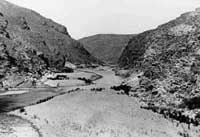
This photo shows the area where Theodore Roosevelt Dam was built. The location originally called "The Crossing" by early Arizona pioneers was the place in the Salt River where Indians, farmers, and ranchers would ford the river. The site is situated in a narrow gorge a short distance below the confluence of the Salt River and Tonto Creek. Originally known as the Tonto Site, the natural dam location attracted the interest of Arizona farmers. A wagon, horses and people prepare to cross the river.
FIRST STONE
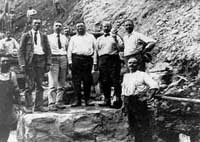
All the big names gather around as the first stone is laid in the Salt River at Roosevelt Dam. From left to right: Dan Carr, Chester Smith, Reclamation Service construction engineer; J.M. O'Rourke, contractor; Mr. Steinmetz, contractor; L.C. Hill, U.S. Reclamation Service engineer in charge; John Urquehart, construction inspector; and an unknown dignitary.
September 20, 1906
Work in Progress: This photo was taken November 1, 1909.
It shows the progress to that point.
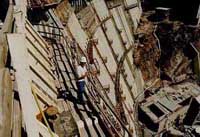
Reclamation's former Resident Engineer, John Wilkie, oversaw construction at the height of Safety of Dams modifications at Theodore Roosevelt Dam. Wilkie, was named Resident Engineer of the Year by the American Society of Civil Engineers in 1989. "This dam is part of me forever," he says, "Nothing I've done compares with being part of this great work."
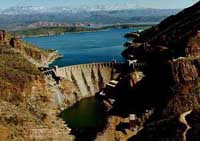
Theodore Roosevelt Dam prior to safety modifications:
Prior to Safety of Dams Modifications, historic Roosevelt Dam looked primarily the same as when first dedicated March 18, 1911 by former President Theodore Roosevelt.
THE CHANGING FACE OF ROOSEVELT DAM
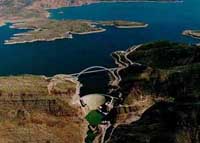 Note: The new Roosevelt Lake Bridge seen in the background.
Note: The new Roosevelt Lake Bridge seen in the background. Prior to completion of the bridge in October 1990, traffic drove over the top of the dam. The bridge itself earned rare distinction when the bridge was named one of the top 12 bridges in the nation in November 1995. The American Consulting Engineers Council cited the bridge for overall design, size, eye-appeal and design challenge. Other bridges cited were the Golden Gate Bridge and Brooklyn Bridge.
The $21.3 million bridge was built to take traffic off the top of Roosevelt Dam. Roosevelt Lake Bridge is the longest two-lane, single-span, steel-arch bridge in North America. The bridge, spans 1,080 feet across Roosevelt Lake providing two-way traffic. The original dam-top roadway was designed to allow two Model-T Fords to pass abreast, but today's recreational vehicles and full-size automobiles are too wide to permit two-way traffic.
THE UNITED STATES FOREST SERVICE
VISITOR'S CENTER AT ROOSEVELT LAKE
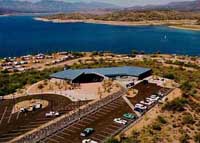
The $2.3 million Roosevelt Lake Visitor's center was built with Bureau of Reclamation funds which were earmarked for use by the U.S. Forest Service for the design and construction of recreational facilities under the terms of the Federal Water Recreation Act. In addition, $42 million was used to replace all lake side facilities that would be impacted by the new higher lake levels as a result of increased capacity for conservation storage and flood surcharge storage.
Some of those recreational facilities include new boat launching ramps, a marina, campgrounds, groups use areas, picnic sites, recreational vehicle parks, and more.
THE FLOODS OF 1993
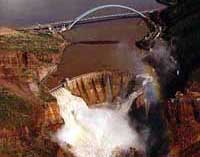 Spillway releases reached 40,000 cubic feet per second and overtopping of the left side cofferdam began early January 19, 1993, discharging water through
the then partially constructed left spillway onto the powerhouse below. This caused $1 million in damage and set the job back nearly six months.
Record rainfall in January 1993 forced the operation of the eight available spillway gates on the right abutment, requiring evacuation of the
downstream (tailrace) area and excavation of the downstream cofferdam crest. A four hour peak inflow of 140,000 cfs was recorded January 8, 1993,
with a maximum five day volume of 580,000 acre feet. A second storm caused the reservoir to rise to elevation 2,139.1 feet January 19, the highest
in the dams history. Overtopping of the left abutment cofferdam crest at elevation 2,138 feet began early January 19 and continued for nearly two
days, discharging up to 700 cfs through the partially constructed spillway and onto the powerhouse below. Spillway gates were opened again February 12
and releases continued until March 8, 1993.
Spillway releases reached 40,000 cubic feet per second and overtopping of the left side cofferdam began early January 19, 1993, discharging water through
the then partially constructed left spillway onto the powerhouse below. This caused $1 million in damage and set the job back nearly six months.
Record rainfall in January 1993 forced the operation of the eight available spillway gates on the right abutment, requiring evacuation of the
downstream (tailrace) area and excavation of the downstream cofferdam crest. A four hour peak inflow of 140,000 cfs was recorded January 8, 1993,
with a maximum five day volume of 580,000 acre feet. A second storm caused the reservoir to rise to elevation 2,139.1 feet January 19, the highest
in the dams history. Overtopping of the left abutment cofferdam crest at elevation 2,138 feet began early January 19 and continued for nearly two
days, discharging up to 700 cfs through the partially constructed spillway and onto the powerhouse below. Spillway gates were opened again February 12
and releases continued until March 8, 1993.CHALLENGES
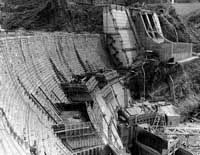 A challenging aspect of the Theodore Roosevelt Dam modification project was designing a concrete overlay for the dam that would be compatible with the
underlying masonry structure. The Bureau of Reclamation chose a single-curvature approach using conventional mass concrete placed in 10-feet high,
70-feet wide blocks, ranging in thickness from 10 to 50 feet. The first concrete block was placed in September 1992 and the final block was placed
June 28, 1995 raising the dam to 357 feet tall. The additional 77 feet of dam height increased the water conservation storage capacity by 20 percent
and provides for more than 1.8 million acre-feet of flood storage. The new mass concrete blocks with vertical joints were placed as alternating odd-even cantilevers. Reclamation's quality control testing program requires close inspection of the concrete batching and placing operations, and regular testing of cast
concrete and concrete components. Mass concrete compressive strengths average 800 pounds per square inch in seven days based on 12 by 24 inch cylinders,
and 4,500 pounds per square inch in one year based on 12 inch cores.
A challenging aspect of the Theodore Roosevelt Dam modification project was designing a concrete overlay for the dam that would be compatible with the
underlying masonry structure. The Bureau of Reclamation chose a single-curvature approach using conventional mass concrete placed in 10-feet high,
70-feet wide blocks, ranging in thickness from 10 to 50 feet. The first concrete block was placed in September 1992 and the final block was placed
June 28, 1995 raising the dam to 357 feet tall. The additional 77 feet of dam height increased the water conservation storage capacity by 20 percent
and provides for more than 1.8 million acre-feet of flood storage. The new mass concrete blocks with vertical joints were placed as alternating odd-even cantilevers. Reclamation's quality control testing program requires close inspection of the concrete batching and placing operations, and regular testing of cast
concrete and concrete components. Mass concrete compressive strengths average 800 pounds per square inch in seven days based on 12 by 24 inch cylinders,
and 4,500 pounds per square inch in one year based on 12 inch cores.

